2021 MERCEDES-BENZ GLE COUPE light
[x] Cancel search: lightPage 196 of 466
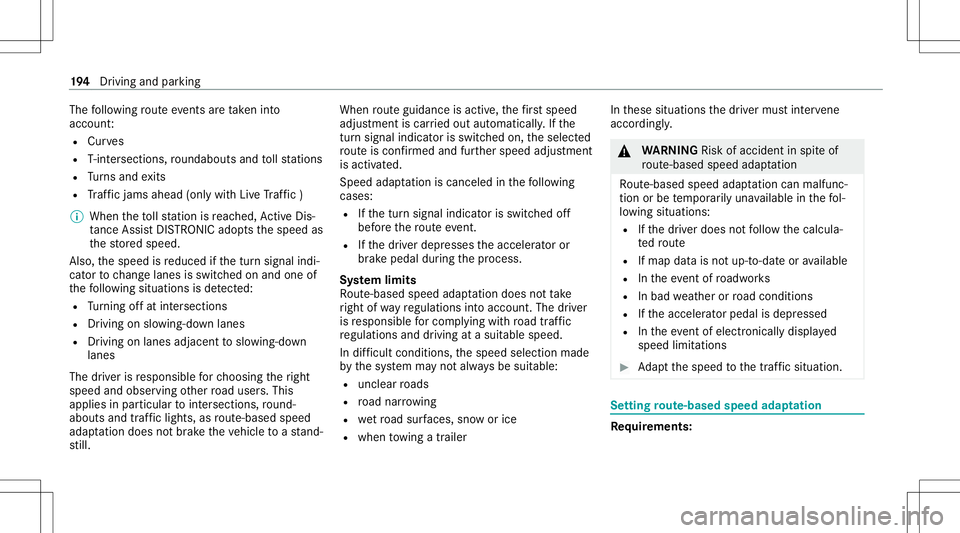
The
follo wing routeeve nts areta ke nint o
acco unt:
R Curves
R T-int ersect ions,ro und about sand tollst atio ns
R Turnsand exits
R Traf fic jams ahead(only with Liv eTr af fic )
% Whe nth eto llst atio nis reac hed, ActiveDis ‐
ta nce AssistDIS TRONI Cad op tsthespeed as
th estor ed speed.
Also, thespeed isreduced ifth etur nsignal indi‐
cat ortochang elane sis swit ched on and one of
th efo llo wing situat ionsisde tected:
R Turning offat intersect ions
R Drivin gon slowing- down lanes
R Drivin gon lanes adjacenttoslo wing-do wn
lanes
The driver isresponsible forch oosing theright
speed andobser vingother road user s.This
applies inpar ticular tointersect ions,ro und ‐
about sand traffic lights, asroute-based speed
adap tatio ndo es notbr ak eth eve hicle toast and‐
st ill. When
routeguidan ceisact ive, thefirs tsp ee d
ad jus tment iscar ried out automaticall y.Ifth e
tur nsigna lind icatoris swi tched on,theselect ed
ro uteis co nfirmed andfurther speed adjustment
is activ ated.
Speed adaptatio nis canc eled inthefo llo wing
cases :
R Ifth etur nsignal indicat orisswitc hedoff
bef oreth ero uteeve nt.
R Ifth edr iver depr esses theacceler ator or
br ak epedal during thepr ocess.
Sy stem limit s
Ro ute-based speedadap tatio ndo es notta ke
ri ght ofwa yre gulations intoaccount .The driver
is responsible forcom plying withro ad traf fic
re gulations anddriving atasuit able speed.
In dif ficul tcondi tions,th espeed selectionmade
by thesy stem mayno talw aysbe suit able:
R unclear roads
R road nar row ing
R wetro ad sur faces, snowor ice
R whe nto wing atrailer In
these situation sth edr iver mus tint erve ne
acco rding ly. &
WARNIN GRisk ofacci dent inspi teof
ro ute-based speedadap tatio n
Ro ute-based speedadap tatio ncan malfunc‐
tio nor be temp orarily una vailable inthefo l‐
lo wing situat ions:
R Ifth edr iver does notfo llo wthecalcula‐
te dro ute
R Ifmap datais no tup-t o-dat eor available
R Intheeve ntofroadw orks
R Inbad weather orroad con dition s
R Ifth eaccelera torpeda lis depr essed
R Intheeve ntofelectr onicallydispla yed
speed limitations #
Adaptth espeed tothetraf fic situ ation. Se
tting rout e-base dspee dadap tation Re
quirement s: 19
4
Driving and parking
Page 198 of 466
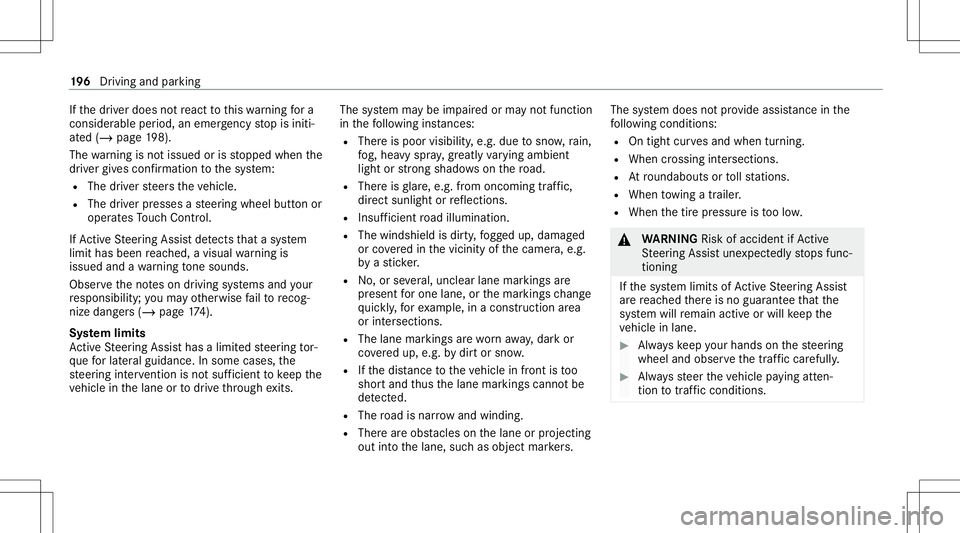
If
th edr iver does notre act tothis wa rning fora
consider ableper iod, anemerg encystop isiniti‐
at ed (/ page19 8).
The warning isno tissued orisstopped whenthe
dr iver giv es con firm atio nto thesy stem:
R The driver steer sth eve hicle.
R The driver presses ast eer ing wheel buttonor
oper ates Touc hCon trol.
If Ac tiveSt eer ing Assis tde tects that asy stem
limit hasbeen reac hed, avisual warning is
issued andawa rning tone sou nds.
Obs erve theno teson driving systems andyour
re sponsibili ty;yo uma yot her wise failto recog‐
nize dangers(/ page 174).
Sy stem limit s
Ac tiveSt eer ing Assis thas alimit edsteer ing tor‐
qu efo rlat eral gui dance. Insome cases, the
st eer ing interve ntio nis no tsu fficien tto keep the
ve hicle inthelane ortodrive th ro ugh exits. The
system maybe impair edorma yno tfunc tion
in thefo llo wing instances:
R The reispoor visibilit y,e.g. due tosno w,rain,
fo g, hea vyspr ay,gr eatl yva rying ambien t
light orstro ng sha dows onthero ad.
R Ther eis glar e, e.g .fr om oncom ingtraf fic,
di re ct sunli ght orreflect ions.
R Insuf ficie ntroad illumin ation.
R The wind shieldisdir ty,fo gg ed up, damag ed
or coveredin thevicinit yof thecamer a,e.g.
by ast icke r.
R No, orseveral,unc lear lane markingsare
pr esen tfo rone lane, orthemar king sch ang e
qu ickl y, forex am ple, inacon stru ction area
or intersecti ons.
R The lane mar kings arewornaw ay,dar kor
co veredup, e.g. bydirtor sno w.
R Ifth edis tance totheve hicle infront istoo
shor tand thus thelane marking scann otbe
de tected.
R The road isnar row and wind ing.
R Ther ear eobs tacle son thelane orprojec ting
out intoth elane, suchas objec tmar kers. The
system does notpr ov ide assis tance inthe
fo llo wing condition s:
R Ontigh tcur vesand when turning.
R When crossing intersections.
R Atround about sor tollst atio ns.
R When towing atrailer .
R When thetir epr essur eis toolow. &
WARNIN GRisk ofacci dent ifAc tive
St eer ing Assis tune xpect edlyst ops func‐
tionin g
If th esy stem limits ofActiveSt eer ing Assis t
ar ere ac hed ther eis no guar anteethat the
sy stem will remain activeor wil lke ep the
ve hicle inlane. #
Alw ayske ep your han dson thesteer ing
wheel andobser vethetra ffic car efull y. #
Alw aysst eer theve hicle paying atten‐
tion totraf fic condi tions. 19
6
Driving and parking
Page 200 of 466

&
WARNIN GRisk ofacci dent whench ang ‐
ing lane toan occ upied adjacentlane
Lan eChan geAssi stcanno tal wa ys cle arly
de tect ifth eadjacen tlane isfree.
The lane chang emigh tbe init iated although
th eadjacen tlane isno tfr ee. #
Beforech ang inglane s,mak esur eth at
th eneighbor inglane isfree and ther eis
no dang ertoother road user s. #
Mon itor thelane chang e. &
WARNIN GRisk ofacci dent ifLane
Ch ang eAssi stune xpectedl yst ops func‐
tionin g
If th esy stem limit ations forLane Change
Assis tha ve been reac hed, ther eis no guar‐
ant eethat thesy stem will remain active.
Lane ChangeAssis tcanno tth en assis tyo u
by appl ying steer ing torq ues . #
Alw aysmonit orthelane chang eand
ke ep your han dson thesteer ing wheel. Obser
vethetra ffic con dition sand steer
and/or brak eif neces sary. Sy
stem limit s
The system limit ations ofActiveSt eer ing Assis t
apply toActiveLa ne Chang eAssi st
( / pag e19 5).
Th esy stem mayalso beimpair edorma yno t
func tion inthefo llo wing situat ions:
R The sensorsin there ar bum peraredir ty,
damag edorcoveredby ast icke ror ice and
sno w,forex am ple.
R The exterior lighting showsadef ect.
% The ActiveLa ne Chang eAssi stsensor s
adjus taut omaticall ywhile acer tain dis tance
is be ing driven afte rth eve hicle hasbeen
deliv ered. ActiveLa ne Chang eAssi stis
una vailable oronl ypar tiall yav ailable during
th is teac h-in proce ss;noarro w appear sne xt
to theØ ActiveSt eer ing Assis tsymbol
when thetur nsignal indicat orisactiv ated. Ac
tiv atin g/deac tivatin gAc tiv eLan eCha nge
As sist Multimedia
system:
4 © 5
Set ting s5
Assist ance
5 Act ive Lane Change Assist #
Activateor deacti vate thefunc tion. Fu
nction ofActiv eEme rgency Stop Assis t If
th esy stem detects that thedr iver has not
st eer edtheve hicle fora consider ableper iod of
time orhas remo vedth eir hands from thesteer‐
ing wheel, display1 appear sin themultifunc ‐
tion displa y.Ifth edr iver still does notst eer the 19
8
Driving and parking
Page 201 of 466
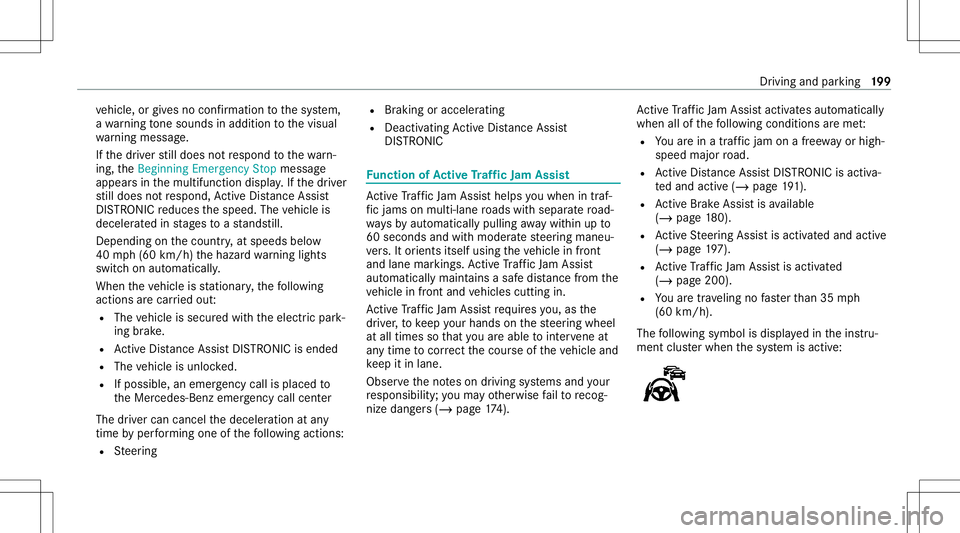
ve
hicle, orgiv es no conf irmation tothesy stem,
a wa rning tone sou nds inad ditio nto thevisual
wa rning mess age.
If th edr iver still does notre spond tothewa rn‐
ing, theBeginn ingEmer gencySt op messag e
appear sin themultifunc tiondispla y.Ifth edr iver
st ill does notre spond, ActiveDis tance Assist
DIS TRONI Creduces thespeed. Thevehicle is
deceler ated instag es toast ands till.
De pen dingon thecount ry,at speeds below
40 mph(60 km/h) thehazar dwa rning light s
switc hon aut omat ically.
When theve hicle isstatio nary,thefo llo wing
act ions arecar ried out :
R The vehicle issecur edwithth eelectr icpar k‐
ing brak e.
R ActiveDis tance AssistDIS TRONI Cis end ed
R The vehicle isunloc ked.
R Ifpossible, anemer gency callis place dto
th eMer cedes- Benzemergency callcent er
The driver can cance lth edeceler ationatany
time byper form ing one ofthefo llo wing actions :
R Steer ing R
Braking oracceler ating
R Deact ivating ActiveDis tance Assist
DIS TRONI C Fu
nction ofActiv eTr af fic Jam Assis t Ac
tiveTr af fic Ja m Assi sthelps youwhen intraf‐
fi c jams onmul ti-la neroads withsepar atero ad‐
wa ys by aut omat icallypullin gaw ay wit hin upto
60 seconds andwithmode rate steer ing maneu‐
ve rs.It or ients itselfus ing theve hicle infront
and lane markings. ActiveTr af fic Ja m Assi st
aut omat icallymain tains asaf edis tance from the
ve hicle infront and vehicles cuttingin.
Ac tiveTr af fic Ja m Assi strequ ires you, as the
dr iver ,to keep your han dson thesteer ing wheel
at all times sothat youar eable tointerve ne at
an ytime tocor rect thecour seoftheve hicle and
ke ep itin lane.
Obser vetheno teson driving systems andyour
re sponsibili ty;yo uma yot her wise failto recog‐
nize dangers(/ page 174). Ac
tiveTr af fic Ja m Assi stact ivat es aut omat ically
when allofthefo llo wing condition sar eme t:
R Youar ein atraf fic jam onafree wa yor high -
spe edmajorro ad.
R ActiveDis tance AssistDIS TRONI Cis acti va‐
te dand activ e(/ page19 1).
R ActiveBr ak eAssi stisavailable
(/ page18 0).
R ActiveSt eer ing Assis tis activ ated and activ e
(/ page19 7).
R ActiveTraf fic Ja m Assi stisact ivat ed
(/ page200).
R Youar etrave ling nofaster than 35 mph
(60 km/ h).
The follo wing symbol isdispla yedin theins tru‐
ment clusterwhen thesy stem isactiv e: Dr
iving andparking 19
9
Page 205 of 466
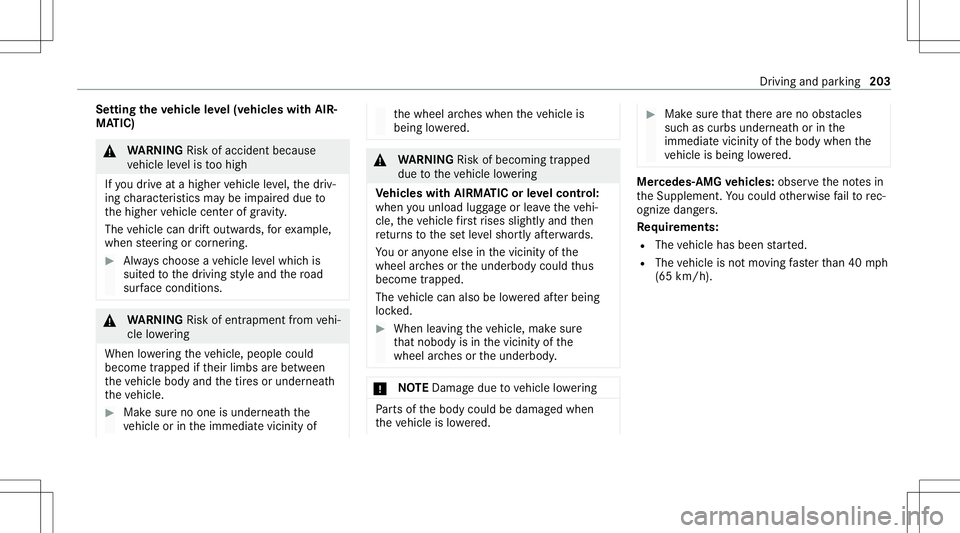
Se
tting theve hicl eleve l(v ehicles withAIR‐
MA TIC) &
WARNIN GRisk ofacci dent because
ve hicle leve lis toohigh
If yo udr ive at ahigh ervehicle leve l,th edr iv‐
ing charact eristic sma ybe impair eddue to
th ehigher vehicle centerofgrav ity .
The vehicle candrift outw ards, forex am ple,
when steer ing orcor ner ing. #
Alw aysch oose ave hicle leve lwhic his
suit edtothedr iving style and thero ad
sur face condi tions. &
WARNIN GRisk ofentr apment from vehi‐
cle lowe ring
Whe nlowe ring theve hicle, people could
become trapped ifth eir limbs arebe tween
th eve hicle body andthetir es orunder neath
th eve hicle. #
Mak esur eno one isunder neathth e
ve hicle orintheimmediat evicinit yof th
ewheel arch es when theve hicle is
being lowe red. &
WARNIN GRisk ofbeco ming trap ped
du eto theve hicle lowe ring
Ve hicl eswith AIRMA TICorleve lcontr ol:
when youunlo adlugg ageor lea vetheve hi‐
cle, theve hicle firs trises slightly andthen
re tur ns tothese tle ve lshor tly af te rw ards.
Yo uor anyone else inthevicinit yof the
wheel arch es ortheunderbody couldthus
bec ome trapped.
The vehicle canalso belowe redaf te rbeing
loc ked. #
When leaving theve hicle, makesur e
th at nobody isin thevicinit yof the
wheel arch es ortheunderbody . *
NO
TEDama gedue tovehicle lowe ring Pa
rts of thebody could bedamag edwhen
th eve hicle islowe red. #
Mak esur eth at ther ear eno obs tacle s
su ch ascur bsunde rneat hor inthe
immed iatevicin ityofthebody when the
ve hicle isbeing lowe red. Mer
cedes- AMGvehicl es:obse rveth eno tesin
th eSupplement .Yo uco uld other wise failto rec‐
ogni zedangers.
Re quirement s:
R The vehicle hasbeen star ted.
R The vehicle isno tmo ving faster than 40 mph
(65 km/ h). Dr
iving andparking203
Page 206 of 466
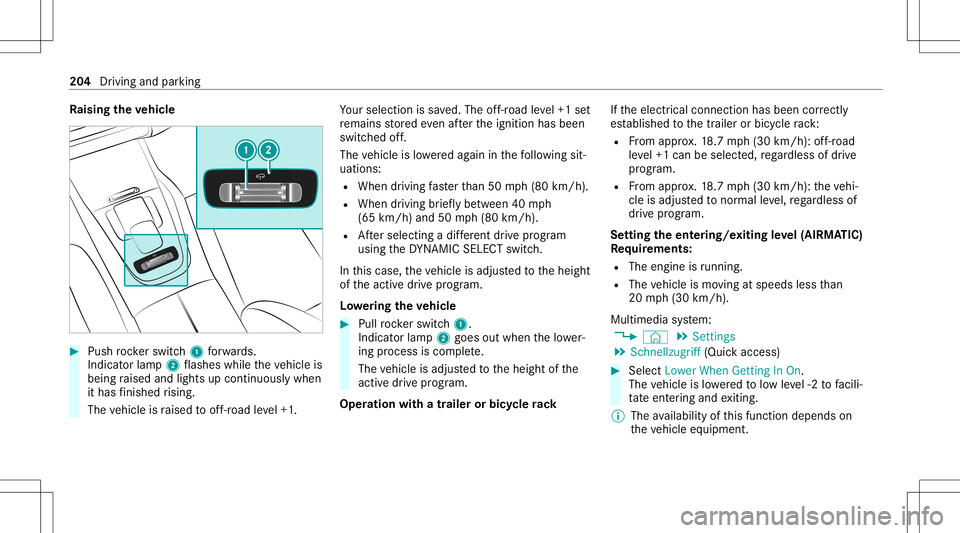
Ra
ising theve hicl e #
Push rock er switc h1 forw ards.
In dicat orlam p2 flashes whiletheve hicle is
being raised andlight sup con tinuousl ywhen
it has finis hed rising.
The vehicle israised tooff-r oad leve l+1 . Yo
ur sele ction issave d. The off-r oad leve l+1 set
re mains stor ed eve naf te rth eignition hasbeen
switc hedoff.
The vehicle islowe redag ain inthefo llo wing sit‐
uation s:
R When drivin gfa ster than 50 mph(80 km/h).
R When driving brief lybe tween 40mph
(65 km/ h)and 50mph(80 km/h).
R Aftersele cting adif fere nt drive pr ogr am
us ing theDY NA MIC SELE CTswitc h.
In this case, theve hicle isadjus tedto theheight
of theactiv edr ive pr og ram.
Lo we ring theve hicl e #
Pullro ck er switc h1.
Indic ator lam p2 goes outwhen thelowe r‐
ing process iscom plete.
The vehicle isadjus tedto theheight ofthe
act ive dr ive pr ogram.
Oper ation withatrailer orbicy clerack If
th eelectr icalconnect ionhas been correctly
es tablished tothetra iler orbicy clerack :
R From appr ox.18 .7 mp h(3 0km/h): off-r oad
le ve l+1 can beselec ted, rega rdless ofdrive
pr ogr am.
R From appr ox.18 .7 mp h(3 0km/h): theve hi‐
cle isadjus tedto nor malle ve l,re ga rdless of
dr ive pr og ram.
Se tting theent ering/e xiting leve l(AIRMA TIC)
Re quirement s:
R The engin eis running .
R The vehicle ismo ving atspeeds lessthan
20 mph(30 km/h).
Multimedia system:
4 © 5
Set ting s
5 Sch nellzugrif f(Quic kaccess) #
Select LowerWhenGettingIn On .
The vehicle islowe redto low leve l-2 tofacil i‐
ta te ent ering and exitin g.
% The availabilit yof this func tion depen dson
th eve hicle equipment. 20
4
Driving andparking
Page 210 of 466

%
Car wash leve lis +1 .6 in(40 mm) abovethe
maximu mvehicle height (raised leve l). Driv‐
ing intounder ground carparksatcar wash
le ve lri sk sdamagi ngtheve hicle.
Fu nction ofRO AD SUR FACE SCAN
% This function isno tav ailable inall coun tries.
The ROAD SUR FACE SCAN function mon itor sth e
ro ad infron tof your vehicle using multifunction
camer a(/ page17 4). ROAD SUR FACE SCAN
de tects une venness inthero ad sur face, e.g.
bu mp s,bef oreth eve hicle drives ove rth em.
Chassis movements arere duced anddriving
comf ortis incr eased.
RO AD SUR FACE SCAN isaut omat icallyact ivat ed
if th efo llo wing condition sar eme t:
R The drive pr ogr am A orN isselect ed.
R The vehicle issetto thenor mal leve l.
R Youar edr ivin gat aspee dbe tween 4mp h
(7 km/ h)and 112mp h(1 80 km/h) . Sy
stem limit s
RO AD SUR FACE SCAN can beimpair edinthe
fo llo wing situat ionsorcan stop funct ioning:
R Ifth ero ad isins ufficie ntlylit, e.g. atnigh t.
R Insno w,rain, fog, hea vyspr ay,if th er eis
gl ar e, indir ect sunlight oringrea tly varying
ambien tlight .
R Ifth ewindshield inthear ea ofmultifunc tion
camer a1 isdir ty,fo gg ed up, damag edor
co vered.
R Ifth ero ad sur face hasno optic stru ctur eor
re flect slight.
R Ifyo uar edr ivin gto oclose totheve hicle in
fr ont.
R Ifsections ofthero uteha ve ave ry small
ra dius ofcur vatur e.
R Dur ing abrupt driving maneuv ers, e.g. heavy
br aking orsudden acceleration.
Obser vetheno teson cleaning themultifunc tion
camer a(/ page299). Fu
nction ofreco very mode &
WARNIN GRisk ofinju rydue totheve hi‐
cle moving upand down
Dur ing reco very mode, theve hicle movesup
and down and cancause injuries. #
When activating reco very mode, make
cer tain that no oneis in thevicin ityof
th eve hicle. *
NO
TERisk ofdama gedue totheve hicle
mo ving upand down When
free driving mode isactiv ated, the
ve hicle movesup and down. Vehicle parts
ma ybe damag edifth eunderbody bottoms
out. #
Mak esur eth at ther eis suf ficie nt
gr ou nd clearance whenro ck ing free
mode isact ivat ed. Re
covery mode isafunction ofthesuspension
whic hcan assis tth edr iver on loose surfaces
(e.g .sand ,sno w)whe nfreei ng ave hicle which
has become stuc k. 208
Driving andparking
Page 212 of 466
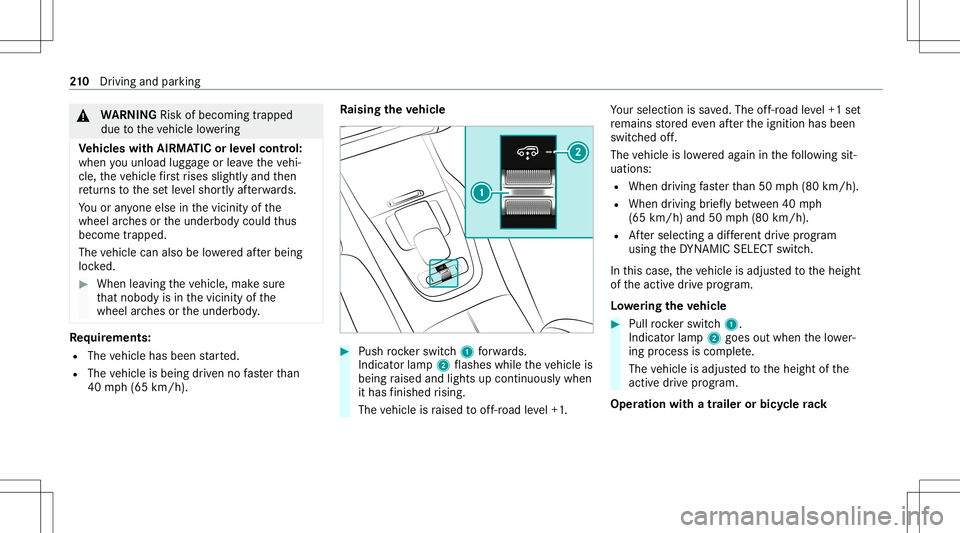
&
WARNIN GRisk ofbeco ming trap ped
du eto theve hicle lowe ring
Ve hicl eswith AIRMA TICorleve lcontr ol:
when youunlo adlugg ageor lea vetheve hi‐
cle, theve hicle firs trises slightly andthen
re tur ns tothese tle ve lshor tly af te rw ards.
Yo uor anyone else inthevicinit yof the
wheel arch es ortheunderbody couldthus
bec ome trapped.
The vehicle canalso belowe redaf te rbeing
loc ked. #
When leaving theve hicle, makesur e
th at nobody isin thevicinit yof the
wheel arch es ortheunderbody . Re
quirement s:
R The vehicle hasbeen star ted.
R The vehicle isbeing driven no faster than
40 mph(6 5km/h). Ra
ising theve hicl e #
Push rock er switc h1 forw ards.
In dicat orlam p2 flashes whiletheve hicle is
being raised andlight sup con tinuousl ywhen
it has finis hed rising.
The vehicle israised tooff-r oad leve l+1 . Yo
ur sele ction issave d. The off-r oad leve l+1 set
re mains stor ed eve naf te rth eignition hasbeen
switc hedoff.
The vehicle islowe redag ain inthefo llo wing sit‐
uation s:
R When drivin gfa ster than 50 mph(80 km/h).
R When driving brief lybe tween 40mph
(65 km/ h)and 50mph(80 km/h).
R Aftersele cting adif fere nt drive pr ogr am
us ing theDY NA MIC SELE CTswitc h.
In this case, theve hicle isadjus tedto theheight
of theactiv edr ive pr og ram.
Lo we ring theve hicl e #
Pullro ck er switc h1.
Indic ator lam p2 goes outwhen thelowe r‐
ing process iscom plete.
The vehicle isadjus tedto theheight ofthe
act ive dr ive pr ogram.
Oper ation withatrailer orbicy clerack 21
0
Driving and parking